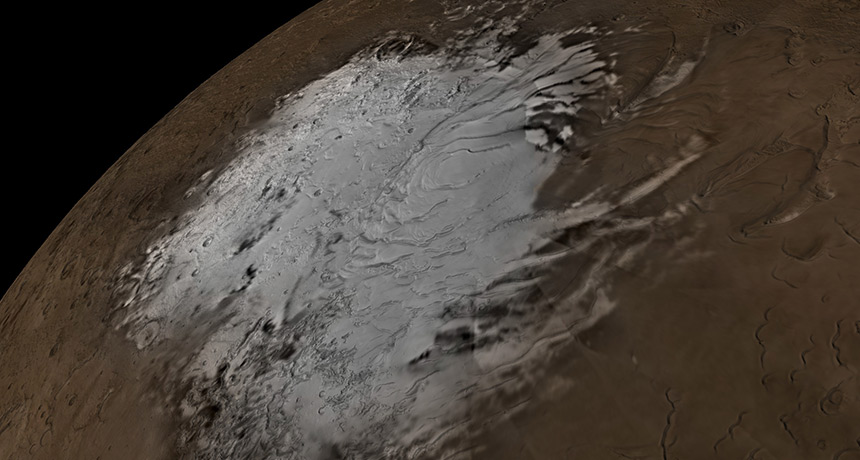Mars (probably) has a lake of liquid water

A Mars orbiter has detected a wide lake of liquid water hidden below the planet’s southern ice sheets. There have been much-debated hints of tiny, ephemeral amounts of water on Mars before. But if confirmed, this lake marks the first discovery of a long-lasting cache of the liquid.
“This is potentially a really big deal,” says planetary scientist Briony Horgan of Purdue University in West Lafayette, Ind. “It’s another type of habitat in which life could be living on Mars today.”
The lake is about 20 kilometers across, planetary scientist Roberto Orosei of the National Institute of Astrophysics in Bologna, Italy and his colleagues report online July 25 in Science — but the water is buried beneath 1.5 kilometers of solid ice.
Orosei and colleagues spotted the lake by combining more than three years of observations from the European Space Agency’s orbiting Mars Express spacecraft. The craft’s MARSIS instrument, which stands for Mars Advanced Radar for Subsurface and Ionosphere Sounding, aimed radar waves at the planet to probe beneath its surface.
As those waves passed through the ice, they bounced off different materials embedded in the glaciers. The brightness of the reflection tells scientists about the material doing the reflecting — liquid water makes a brighter echo than either ice or rock.
Combining 29 radar observations taken from May 2012 to December 2015, MARSIS revealed a bright spot in the ice layers near Mars’ south pole, surrounded by much less reflective areas. Orosei and colleagues considered other explanations for the bright spot, such as radar bouncing off a hypothetical layer of carbon dioxide ice at the top of the sheet, but decided those options either wouldn’t produce the same radar signal or were too contrived to be physically likely.
That left one option: A lake of liquid water. Similar lakes beneath the ice in Antarctica and Greenland have been discovered in the same way (SN: 9/7/13, p. 26).
“On Earth, nobody would have been surprised to conclude that this was water,” Orosei says. “But to demonstrate the same on Mars was much more complicated.”
The lake is probably not pure water — temperatures at the bottom of the ice sheet are around –68° Celsius, and pure water would freeze there, even under the pressure of so much ice. But a lot of salt dissolved in the water could lower the freezing point. Salts of sodium, magnesium and calcium have been found elsewhere on Mars, and may be helping to keep this lake liquid (SN: 4/11/09, p. 12). The pool could also be more mud than water, but that could still be a habitable environment, Horgan says.
Previously, scientists have discovered extensive solid water ice sheets under the Martian dirt (SN Online: 1/11/18). There were also hints that liquid water flowed down cliff walls (SN: 10/31/15, p. 17), but those may turn out to be tiny dry avalanches. The Phoenix lander saw what looked like frozen water droplets at its site near the north pole in 2008, but that water may have been melted by the lander itself (SN Online: 9/9/10).
“If this [lake] is confirmed, it’s a substantial change in our understanding of the present-day habitability of Mars,” says Lisa Pratt, NASA’s planetary protection officer.
Though the newly discovered lake’s depth is unclear, its volume still dwarfs any previous signs of liquid water on Mars, Orosei says. The lake has to be at least 10 centimeters deep for MARSIS to have noticed it. That means it could contain at least 10 billion liters of liquid water.
“That’s big,” Horgan says. “When we’ve talked about water in other places, it’s in dribs and drabs.”
Under-ice lakes on Mars were first suggested in 1987, and the MARSIS team has been searching since Mars Express began orbiting the Red Planet in 2003. It took the team more than a decade to collect enough data to convince themselves the lake was real.
For the first several years of observations, limitations in the spacecraft’s onboard computer forced the team to average hundreds of radar pulses together before sending the data back to Earth. That strategy sometimes cancelled out the lake’s reflections, Orosei says — on some orbits, the bright spot was visible, on others, it wasn’t.
In the early 2010s, the team switched to a new technique that let them store the data and send it back to Earth more slowly. Then in August 2015, months before the end of the observing campaign, the experiment’s principal investigator, Giovanni Picardi of the University of Rome Sapienza, died unexpectedly.
“It was incredibly sad,” Orosei says. “We had all the data, but we had no leadership. The team was in disarray.”
Finally discovering the lake is “a testament to perseverance and longevity,” says planetary scientist Isaac Smith of the Planetary Science Institute, who is based in Lakewood, Colo. “Long after everyone else gave up looking, this team kept looking.”
But there is still room for doubt, says Smith, who works on a different radar experiment on NASA’s Mars Reconnaissance Orbiter that has seen no sign of the lake, even in CT scan–like 3-D views of the poles. It could be that MRO’s radar is scattering off the ice in a different way, or that the wavelengths it uses don’t penetrate as deep into the ice. The MRO team will look again, and will also try to create a 3-D view from the MARSIS data. Having a specific spot to aim for is helpful, he says.
“I expect there will be debate,” Smith says. “They’ve done their homework. This paper is well earned. But we should do some more follow-up.”